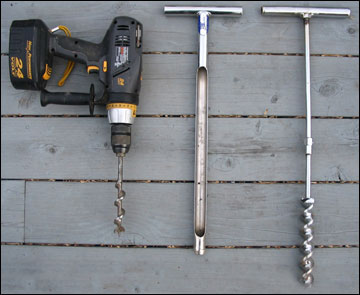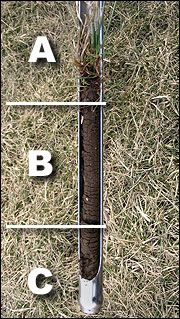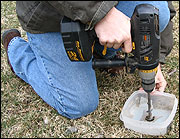How to take a soil sample
These are general guidelines for taking a soil sample. Additional instructions for specific types of soil are provided on those pages. A well-taken soil sample results in appropriate recommended rates of fertilizer and limestone.
Soil samples should consist of uniform soil areas. Each area should have the same soil color and texture, cropping history, and fertilizer, lime and manure treatments. Sample differing areas/composites separately.
Soil sample instructional video:
Soil sampling tools

A soil coring device such as a probe or auger works best to sample soil because these tools equally collect soil from surface through the entire sampling depth. Augers are recommended on rocky soils. Hand samplers at least 3 feet long are desirable because they reduce back strain. Soil probes and augers are available through agriculture companies or your extension specialist may be able to help you locate a supplier.
You can use a shovel, however it is not as good as a probe or auger. If you use a shovel, dig a hole to the proper depth, shave a 1-inch slice from the side of the hole, and save the vertical 1-inch-wide center portion of this slice.
Getting a soil sample

Obtain a six to seven inch core for soil sampling.
- Discard organic duff on top of soil.
- Put six to seven inch soil core in sampling bucket.
- Discard soil below six to seven inches.
In rocky or dry soil

- Use a plastic container with a hole in the middle to collect the soil as the auger pulls it out of the ground.
- Empty the soil out of the plastic container into the soil sample bucket after each successful attempt to get a six-inch core.
Soil tests to request
Regular fertility tests
For a general analysis of a soil's fertility, a regular soil test package includes:
- pH
- Neutralizable acidity
- Phosphorus
- Potassium
- Calcium
- Magnesium
- Organic matter
- Cation exchange capacity
In certain cases additional tests may be required.
- Micronutrients
Zinc, iron, copper and manganese
Micronutrients may be desired in high pH soils - Sulfur
Sandy soils low in organic matter may have sulfur deficiency - Salt content (electrical conductivity)
Soils with salt problems should be tested for salt content (e.g. salt or fertilizer spills, heavy applications of manure, irrigating with alkaline water can lead to salt problems.)
Services for precision agriculture
- Special services and prices are available when a customer submits 50 or more soil samples at one time for precision agriculture purposes.
- Please contact the lab to get specifics on pricing.
- Results can be reported via email in an ASCII comma-delimited format specific for precision ag software. Hard copies of soil test reports can also be mailed out.